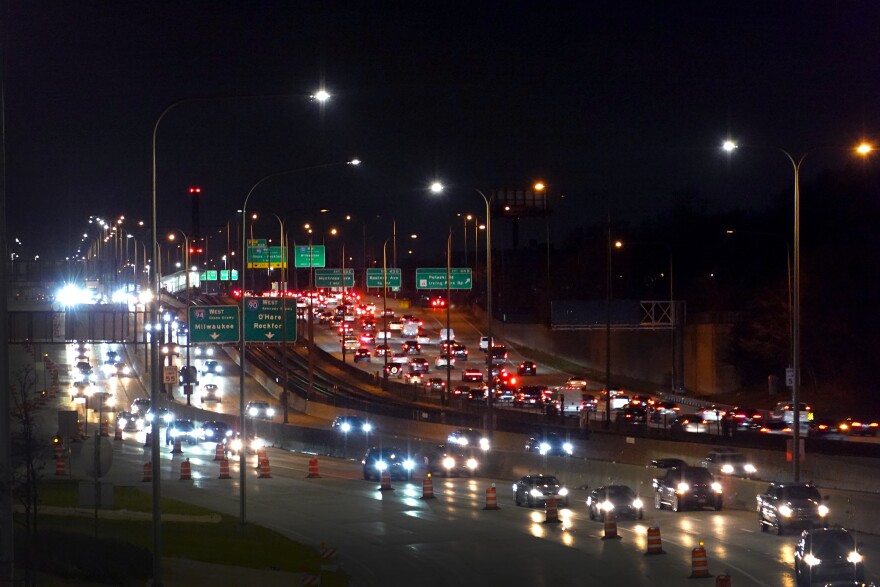Truth matters. Community matters. Your support makes both possible. LAist is one of the few places where news remains independent and free from political and corporate influence. Stand up for truth and for LAist. Make your year-end tax-deductible gift now.
Wondering Why Headlights Seem Brighter? Placement Is Part Of The Problem, Experts Say

As you drive through this most recent rainstorm or when you’re headed home at night, have you ever wondered why headlights seem brighter than they used to be?
Well, you’re not the only one who’s felt blinded by the car behind you. While federal regulations have largely stayed the same, new technology has changed the headlight game.
What’s different
Warm halogen single-beam headlights were the industry norm in America during the 1980s and '90s, but they’ve been steadily replaced by LEDs, especially over the last couple of years.
LEDs are more cost- and energy efficient, but they are “without a doubt whiter in color,” according to Jennifer Stockburger, the director of operations at the Consumer Reports Auto Test Center.
That’s a great thing from a safety perspective, she told LAist, because driving at night is three times riskier than during the day.
“There's absolute benefits to the better visibility that they provide, but there is no question that oncoming drivers or follow-drivers find some discomfort,” Stockburger said.
Now, the LED headlights still fall under federal guidelines for brightness, so why does it seem like there’s such a difference to drivers?
David Aylor is the vice president of active safety at the Insurance Institute for Highway Safety and oversees their headlight testing program. He told LAist when the headlights are tested, they’re not actually attached to the vehicle.
Aylor said that can cause problems on the road, especially when they’re for SUVs and pickup trucks, which he said have become a lot more common lately.
“In many cases, those headlights are mounted much higher,” he said. “Because they're mounted higher, it's much more difficult for those vehicles to reduce the glare and shine in the driver's eyes of other vehicles.”
While the headlights meet requirements during testing, Aylor said they may not be pointed in a way that will reduce glare and increase visibility once it’s actually mounted on the vehicle.
Stockburger said it’s a combination of the new technology and the mounting that’s causing discomfort for drivers.
“If those bright lights are aligned correctly, there shouldn't be a real glare problem,” she noted.
Also, it can seem even worse in wet weather. Aylor and Stockburger said the rain creates more reflective surfaces on the road which helps the headlight glare bounce back into your eyes.
What can you do while driving?
People tend to look directly at oncoming headlights for some unfortunate reason, Stockburger noted, like moths to a flame.
She said we’re looking at the contrast from the older yellowish halogen to the new whiter LEDs.
“If there's a line of traffic coming towards you, you can pick them out,” Stockburger said. “You can say halogen, halogen, LED, LED, because they look so different.”
As a driver, she said you have to train yourself to look towards the right side of the road. Let the white lane lines guide you until those cars pass.
But if you’re feeling very uncomfortable by the headlights behind you, she said don’t hesitate to pull over and let them go by.
With that being said, Stockburger added that when the National Highway Traffic Safety Administration has researched this, it has not been shown to be a cause for crashes.
“I think it's brief enough in its interaction where people aren't actually crashing more because of it,” she said.
What’s next
An even newer headlight technology is coming to America’s fleet.
They’re called adaptive driving beams and have been available in Europe for more than a decade. However, they weren’t allowed in the U.S. until just last year, when the National Highway Traffic Safety Administration updated its regulations.
“It allows the vehicle to have high-beam basically everywhere, except where there are other cars,” Aylor said. “So it uses that [front-facing] camera and the technology to sort of track where other cars are on the road, and the headlights can turn off LEDs in those areas so that you're not glaring cars, but you’re getting high-beam visibility in all the other areas.”
But, it’ll take a while for these new headlights to become common amongst the more than 280 million vehicles on U.S. roads.
The technology is pretty expensive, Aylor noted, and our regulations are slightly different than Europe’s, so it’s taking manufacturers some time to figure out how to make the headlights for the American market.
Stockburger said the technology is available, but mostly on high-end luxury vehicles right now. She said it could take several years until the adaptive driving beams are included in more mainstream affordable options.








